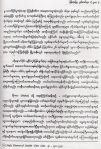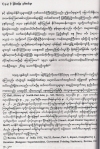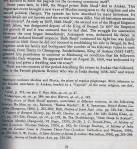Mogul Emperor Shah Jahan’s son Shah Shuja murdered in Burma’s Arakan (in English and Burmese)
This
slideshow requires JavaScript.
The Cambridge History of India
: Shah Shuja in Arakan
Shah Shuja the second son of the Mogul Emperor Shah Jahan. In 1639,
Shah Shuja the second son of the Mogul Emperor Shah Jahan, was
designated deputy of the king of Bengal. The struggle for succession
between the sons began immediately. Aurangzeb won, dethroned his father
in 1658 and declared himself emperor. Shah Shuja continued his fight but
was finally defeated in 1660. Since he did not succeed in establishing
his rule in Bengal, he fled, together with his family and bodyguards,
from Dacca to Chittagong.
Sandathudama, king of Arakan Burma(1652-1687)
granted him permission to continue to Mrohaung
on condition that his followers surrender their weapons. He arrived
there on August 26, 1660, was welcomed by the king and given a dwelling
near the town. There are various versions of the events describing what
happened in Arakan at that time.
According to the archives (Daghrigister) of the Dutch East India Company in Batavial, the Company’s representative and director of the Dutch trading post who was in Mrohaung at the time reported the events to Batavia. He too was not an eye witness but wrote according to rumors heard in the city.
He describes the warm welcome given to
Shah Shuja in 1660, by the Arakan king and his promise to supply the
refugees with ships to take them to Mecca. Eight months passed and the
promise had not been kept.
According to the Dutch representative,
the reason for this was that King Sanda Thudama asked Shah Shuja for a
daughter in marriage… Shah Shuja proudly refused to submit to what he
regarded as a grave dishonour, and as a result friendly relations ceased
between him and the King.
The Dutch East India Company
representative states that Shah Shuja’s followers were murdered on
February 7, 1661, because the prince intended to escape from the King’s
palace and conquer the kingdom of Arakan for himself [For details,
please see G.E.Hervey, The fate of Shah Shuja 1661. Journal of
the Burma
Research Society, part 1, 1922. pp. 107-115]
But who escaped the massacre were later
admitted into the king’s bodyguard as a special archers unit calledKama
ns orKam anci.[ M. Siddique Khan, op, cit., p. 253}]Those of Shah
Shuja’s soldiers who escaped the massacre were later admitted into the
king’s bodyguard as a special archers unit called Kamans or Kamanci
(from the Persian : bow, kaman. bowman Kamaci.) From 1666 to 1710 the
political rule of
Arakan was completely in their hands, during which the Muslim Kaman units played a decisive role of king makers and king breakers. Their numbers were increased from time to time by fresh arrivals from upper India.[ G. E Hervey, History of Burma, London 1925, P. 148. Mohammad Khalilur Rahman, Tarik-i- Islam Arakan & Burma, Urdu version, Quoted by Abdul Haque Chowdhury]
Arakan was completely in their hands, during which the Muslim Kaman units played a decisive role of king makers and king breakers. Their numbers were increased from time to time by fresh arrivals from upper India.[ G. E Hervey, History of Burma, London 1925, P. 148. Mohammad Khalilur Rahman, Tarik-i- Islam Arakan & Burma, Urdu version, Quoted by Abdul Haque Chowdhury]
The historian Sir Arthur P.Phayre thinks
that the Arakanese
Chronicles conceal their king’s ugly behaviour, and emphasize the
prince’s abortive experiment to capture the palace by neglecting to
mention the preceding provocation of not providing the promised ships,
the king’s request to have one of Shah Shuja’s daughter’s in marriage
and his wish to molest the prince’s richest.
Phayre quotes no source for this
‘opinion, which is apparently only his personal point of view, but a
decidedly acceptable one.
Although immediately after Shah Shuja
came to Arakan, Aurangzeb demanded to the Arakan king to deliver the
fleeing prince and his family into his hands. Aurangzeb had been seen to
be quite prepared himself to murder his own brother, but became angry
when the Arakan king dared to harm a member of the Royal Mogul Family.
He decided to use this as an excuse to
put an end to the Portugese Arakanese pirate raids on the East Bengal
coast. In 1665 to 1666 a large Mogul force attacked the Portuguese and
Arakanese, demolished their settlements in Sandwip, destroyed their
navies and conquered Chittagong and Ramu. During their retreat to
Mrohaung, Arakanese army units were also attacked by the local Muslim
population, descendants of the Muslim slaves who had been settled on the
land.
This defeat spelled the end of the power
of the kingdom of Arakan. The death of Sandathudama in 1684, marked the
beginning of a period of anarchy and riots in the kingdom during which the Muslim
Kaman units played a decisive role as makers and displacers of kings.
These units were being continually reinforced by fresh Afghan
mercenaries from North India. From 1666 until 1710 the political rule of
Arakan was completely in their hands. Ten kings were crowned and
dethroned and usually murdered- by them during that period- In 1710 king
Sandawizaya (1710-1731) succeeded in gaining the upper hand over them,
and most of the Kamans were exiled to Rarmee Island.
Their descendants live in Rarmee and in a
few villages near Akyab and still bear the same name to this very day.
Their language is Arakanese and their customs are similar to Arakan
customs in everything except religion Islam.( G. E Hervey, History
of Burma,
London 1925, P. 148. Mohammad Khalilur Rahman, Tarik-i- Islam Arakan
& Burma,
Urdu version, Quoted by Abdul Haque Chowdhury)
Next
source:Shah
Shuja (Mughal) From Wikipedia
Shāh Shujā (June 23,
1616 – 1660) was the second son of the Mughal emperor Shah
Jahan and empress Mumtaz Mahal.
Emperor Shah Jahan appointed Shah Shuja
as the Subahdar or
governor of Bengal
in 1639. In 1642, Shuja was also given the charge of the province of Orissa.
He ruled the provinces for more than twenty years, from 1639 to 1660.
During the period there were two short breaks: first in 1647-1648, when
he was with the emperor on his campaigns against rebels in the Afghan
passes; and the second in 1652, when he was at Kabul for about four
months from April to July. During the later part of his Subahdari, from
1658 he twice proceeded towards the capital in his bid to contest for
the throne.
Shāh Shujā built the Bara Katra
(Bengali: বড় কাটরা) between 1644 and 1646 in Dhaka to serve as his
official residence.
When Shah Jahan fell ill, a struggle for
the throne started between his four sons – Dara Shikoh, Shah
Shuja, Aurangzeb and Murad
Baksh. Shuja immediately crowned himself the emperor and took
imperial titles. He marched with a large army, backed by a good number
of war-boats in the river Ganges. However, he was
beaten by Dara’s army in a hotly contested Battle
of Bahadurpur (in modern Uttar Pradesh, India).
Shuja turned back to Rajmahal to make
further preparations. In the meantime, Aurangzeb defeated
Dara twice (at Dharmat and Samugarh), caught him, executed him on a
charge of heresy and ascended the throne. Shuja marched again to the
capital, this time against Aurangzeb. A battle took place on 5 January
1658 at Khajwa
(Fatehpur district, Uttar Pradesh, India) where
Shuja was defeated.
After his defeat, Shuja retreated
towards Bengal.
He was pursued by the imperial army under Mir Jumla. Shuja put up a
good fight against them. However, he was finally defeated in the last
battle in April 1660. After each defeat he had to face desertions in his
own army, but he did not lose heart. He, rather, reorganised the army
with renewed vigor. But when he was going to be surrounded at Tandah,
and when he found that reorganisation of the army was no longer
possible, he decided to leave Bengal (and India) for good and take
shelter in Arakan. He left
Tanda with his family and retinue in the afternoon of 6 April 1660 and
reached Dhaka
on 12 April. He left Dhaka on 6 May and boarded the Arakanese ships on
12 May at Bhulua (near present-day Noakhali, Bangladesh).
Shuja made contacts with Arakan
before his departure from Bengal. His plan was to go to Mecca and
then to Persia or Turkey. But as the sea
was rough in May and the rainy season, he asked for asylum in Arakan for
a few months and help in procuring ships. On his arrival at Mrohaung
(Mrauk-U), the capital of Arakan, the king warmly received him through
his ministers. A house was allowed for Shuja’s stay in the outskirts of
the city. But as time passed, the king’s attitude to his guest changed;
either for getting hold of rich treasures Shuja carried with him, or to
get one of the pretty and cultured daughters of Shuja as his spouse, the
king picked up a quarrel with Shuja. Shuja, his family and his retinue
were tortured to death. A few of his retinue, fleeing to the
countryside, could escape the gruesome murder, but some of the Mughal
princes and princesses survived.
References
- JN Sarkar (ed), History of Bengal, vol II, Dhaka, 1948
- JN Sarkar, History of Aurangzib, vol II, New Delhi, 1972-74
- A Karim, History of Bengal, Mughal Period, vol II, Rajshahi, 1995.
- The Taj Mahal (jer979.blogspot.com)
- Shah Zafar, the last of the Mughal emperors in India (drkokogyi.wordpress.com)
- The heartbroken ruler behind the Taj Mahal (telegraph.co.uk)
- Beauty treatment for Taj Mahal (kish.in)
- Taj Mahal: a timeline (telegraph.co.uk)
- The Taj Mahal: one of world’s best known monuments (telegraph.co.uk)
- Top 10 mausoleums (telegraph.co.uk)
- 1855 AD Amerapoora Mosque (drkokogyi.wordpress.com)
- Burmese Muslims during Amarapura Kings era (drkokogyi.wordpress.com)












No comments:
Post a Comment